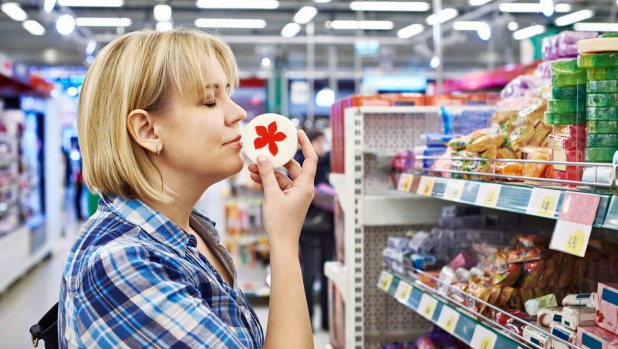The scent of Overdelivering Experiences
We bet you’ve heard it before and not just once: Overdelivering to your customers is the key to success. Focus on offering your community the best experience they could have, and the results will show up naturally.
But what is that supposed to mean when we’re talking about Brand Communication?
Well, offering a 360-branding experience is a complete mix of communication tools experts use, to shape a brand’s identity as authentic and sensorial as possible. This whole package is recommended to reach out the customers through all the 6th senses.
Today, we wanted to focus on the importance of one of these 6th, the olfactory sense, when it comes to brand communication. For that, we approached Alex Cucu, CEO of ScentLinQ, one of the biggest players in the industry in Europe to share with us inside tricks and tools they use to enhance brands identity by using smell. We invite you to check the outcome below!
- BRAND MINDS: Scent::LinQ has worked with a large variety of international brands while being the lead player market. That means you have built a rich background in the industry plus a good indicator that your work delivers satisfactory results. Now the first question would be “how is ScentLinQ helping all these brands to find their olfactory identity”.
In Romania, you collaborate with over 100 companies, many of them multinational, among: Romanian Commercial Bank, Rompetrol, Anchor Group, Global Worth, Tiriac Holding, Bavaria Automobile, Miele Romania, Continental Hotels Romania, Athénée Palace Hilton Bucharest, Dolce & Gabbana, Valentino, Cavalli and others.
ALEX CUCU: Scent::LinQ brand is indeed in 40 countries worldwide and some of the highlights are some special projects such as Hong Kong Airport or Disney Resorts in Orlando USA. Disney recently requested signature scent for 3 main hotel concepts in Orlando resorts. Based on Disney brand and marketing management team’s brief and concept details, we have arranged a conference call with our perfumers in Germany, and we finally come up with 3 different scents that was satisfactory to Disney marketing and branding team. For example, a woody scent Red Sequoia for their Animal Kingdom Lodge. As we say, “the scents that touch emotions”.
- BRAND MINDS: Give us three reasons why is it important for brands to have an olfactory identity. How does that help them?
ALEX CUCU: We use scent as an interior design element, just like proper lighting or right music for a hotel or a retail space. Therefore, it is very important to choose the right scent for the right image or concept. Once the right scent is incorporated into the brand identity, the targeted audience associates the scent with the brand.
- BRAND MINDS: Tell us the best olfactory activation Scent::LinQ has created for a brand and what was the audience’s feedback to it?
ALEX CUCU: We have created a signature scent for Tommy Hilfiger stores in Turkey and their customers liked it so much and they started to ask if the store scent is available as a perfume. Another one is the Disney Resorts in Orlando USA Disney has so many hotel guests keep asking if they can purchase `the Disney hotel scent`?
- BRAND MINDS: What has changed in the past 5 years in brand communication when it comes to scent and what is expected to improve in the next 5 years?
ALEX CUCU: In the past 5 years, the scent factor of the overall brand communication became more noticeable. The retailers and hotels feel almost “naked“ without scenting, they say. We think that the scent branding will have a by-product such as scent related new product lines. For example, Four Seasons Hotels asked us to prepare reed diffuser line made with their hotel signature scents to sell at their SPAs.
- BRAND MINDS: Related to your expertise and vision, what could be the next big thing in this industry?
ALEX CUCU: We are working on a project called SCENTDISQ for home scenting. We think a compact scenting system controlled with a mobile app will be a good add-on to our company. And there is an immense request and feedbacks from people all over the world inquiring our scents for their homes.
The power of smell as a tool in the marketing strategy
Businesses looking to sniff out a commercial opportunity have been aware of its power for a long time. According to the Sense of Smell Institute, people are able to recognize approximately 10,000 different odors and are able to recall smells with 65% accuracy after a year, in contrast to only 50% of visuals after three months.

source: Stuff
Martin Lindstrom found that brand impact increased by 30% when more than one sense is engaged and by a whopping 70% when three senses are integrated into the brand message. Scents have an immediate and compelling effect as they are directly linked to the brains limbic system which is the part of the brain responsible for our memories and emotions. Therefore scents go beyond our rational perception and have an ultimate impact on our emotions.
Moreover, smell is the most powerful and emotional of all the senses. By using scent, brands are able to connect with consumers on a deeper emotional level, resulting in a more memorable experience. Scent can attract new customers, increase sales, heighten value perception, and expand brand recognition and customer satisfaction. A scent has the ability to influence behavior and trigger memories almost instantaneously. When smell is combined with other marketing cues, it can amplify a brand experience and establish a long lasting connection with consumers.
The right scent can depend on several factors. Research by Eric Spangenberg, the dean of the college of business at Washington State University, who has been researching the effect of smell on customer behavior since 1996, has found that it affected everything from cultural norms, gender and appropriateness to the product. “Another area where we’ve seen effects is if you’ve got a scent that’s congruent with a season. So, for instance, shopping and the seasonal effects of scent – people expect Christmas to smell like cinnamon or something like that,” he says.
Comparing this with a scent more appropriate for Easter, he found positive effects for the seasonal smell and negative effects for the incongruous one. “Using the correct smell is crucial. For businesses across many sectors, getting their fragrances right could mean the difference between the lingering stench of failure or the sweet smell of success,” writes The Independent UK.
“Smell has been a somewhat neglected sense in terms of being used to help differentiate brands, so scents are one of the final frontiers for marketers,” explains Maureen Morrin, professor of marketing at Temple University’s Fox School of Business and coauthor of a research study on the effects of ambient scent on consumer preferences and choice behaviors. “Hotels have created their own proprietary scents that are not just emitted in public spaces, such as the lobby and workout rooms but also often integrated into their toiletries. Not only is the odor pleasant, but it also comes to have unique associations with the brand over time,” she added, quoted by Sarah Bergen for Lodging Magazine.
Because sense of smell is tied to the side of the brain that processes memories and emotions, the appropriate use of scent can positively impact the perception of a brand, customer loyalty, and even the attitude of the staff. “We’re where music was 15 years ago. You wouldn’t walk into an established retailer today without some sort of music playing, but that wasn’t the case 15 or 20 years ago. You can walk into a beautifully designed space, and it’s rendered meaningless if there’s a bad smell or an absent smell,” said Roger Bensinger, exec VP of AirQ by Prolitec, which works with Abercrombie & Fitch, Hard Rock Hotel & Casino and Giorgio Armani, among others, quated by AdAge. ”
The researchers hypothesized that the degree of complexity of a scent may affect the consumer’s ability to process that olfactory information. The less complex a scent, the easier it is to process, and the greater its influence on associated attitudes and behaviors. This should translate into more favorable consumer responses to the retail environment and associated products.

